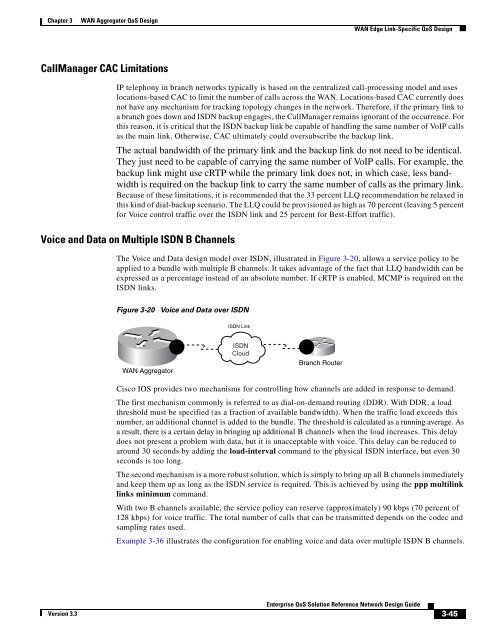Enterprise QoS Solution Reference Network Design Guide
Enterprise QoS Solution Reference Network Design Guide
Enterprise QoS Solution Reference Network Design Guide
Create successful ePaper yourself
Turn your PDF publications into a flip-book with our unique Google optimized e-Paper software.
Chapter 3 WAN Aggregator <strong>QoS</strong> <strong>Design</strong><br />
CallManager CAC Limitations<br />
Version 3.3<br />
WAN Edge Link-Specific <strong>QoS</strong> <strong>Design</strong><br />
IP telephony in branch networks typically is based on the centralized call-processing model and uses<br />
locations-based CAC to limit the number of calls across the WAN. Locations-based CAC currently does<br />
not have any mechanism for tracking topology changes in the network. Therefore, if the primary link to<br />
a branch goes down and ISDN backup engages, the CallManager remains ignorant of the occurrence. For<br />
this reason, it is critical that the ISDN backup link be capable of handling the same number of VoIP calls<br />
as the main link. Otherwise, CAC ultimately could oversubscribe the backup link.<br />
The actual bandwidth of the primary link and the backup link do not need to be identical.<br />
They just need to be capable of carrying the same number of VoIP calls. For example, the<br />
backup link might use cRTP while the primary link does not, in which case, less bandwidth<br />
is required on the backup link to carry the same number of calls as the primary link.<br />
Because of these limitations, it is recommended that the 33 percent LLQ recommendation be relaxed in<br />
this kind of dial-backup scenario. The LLQ could be provisioned as high as 70 percent (leaving 5 percent<br />
for Voice control traffic over the ISDN link and 25 percent for Best-Effort traffic).<br />
Voice and Data on Multiple ISDN B Channels<br />
The Voice and Data design model over ISDN, illustrated in Figure 3-20, allows a service policy to be<br />
applied to a bundle with multiple B channels. It takes advantage of the fact that LLQ bandwidth can be<br />
expressed as a percentage instead of an absolute number. If cRTP is enabled, MCMP is required on the<br />
ISDN links.<br />
Figure 3-20 Voice and Data over ISDN<br />
WAN Aggregator<br />
ISDN Link<br />
ISDN<br />
Cloud<br />
Branch Router<br />
Cisco IOS provides two mechanisms for controlling how channels are added in response to demand.<br />
The first mechanism commonly is referred to as dial-on-demand routing (DDR). With DDR, a load<br />
threshold must be specified (as a fraction of available bandwidth). When the traffic load exceeds this<br />
number, an additional channel is added to the bundle. The threshold is calculated as a running average. As<br />
a result, there is a certain delay in bringing up additional B channels when the load increases. This delay<br />
does not present a problem with data, but it is unacceptable with voice. This delay can be reduced to<br />
around 30 seconds by adding the load-interval command to the physical ISDN interface, but even 30<br />
seconds is too long.<br />
The second mechanism is a more robust solution, which is simply to bring up all B channels immediately<br />
and keep them up as long as the ISDN service is required. This is achieved by using the ppp multilink<br />
links minimum command.<br />
With two B channels available, the service policy can reserve (approximately) 90 kbps (70 percent of<br />
128 kbps) for voice traffic. The total number of calls that can be transmitted depends on the codec and<br />
sampling rates used.<br />
Example 3-36 illustrates the configuration for enabling voice and data over multiple ISDN B channels.<br />
<strong>Enterprise</strong> <strong>QoS</strong> <strong>Solution</strong> <strong>Reference</strong> <strong>Network</strong> <strong>Design</strong> <strong>Guide</strong><br />
3-45
















